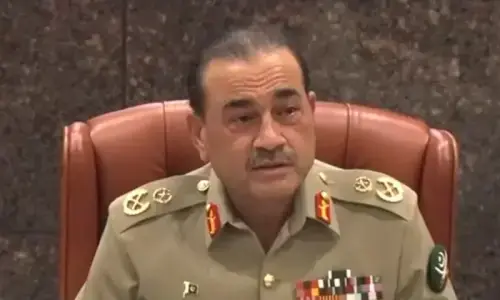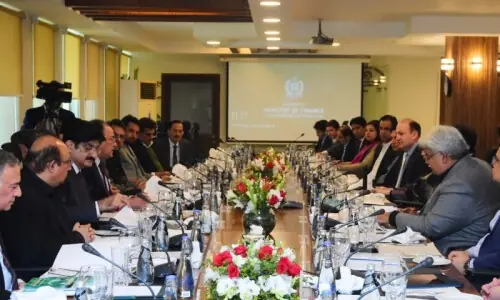 |
| The public hearing organised by the Sindh Environmental Protection Agency on the twin nuclear power plants under way on Monday. —Fahim Siddiqi / White Star |
KARACHI: Representatives of civil society at a public hearing on Monday once again criticised the construction of twin nuclear power plants on the outskirts of Karachi and requested the Sindh Environmental Protection Agency (Sepa) to give at least over two months to go through the voluminous environmental impact assessment (EIA) report and debate the pros and cons of the critical project.
The public hearing, the first on any nuclear power plant in the country, was held on the directives of the Sindh High Court that had stayed the construction of the $10 billion project last year till a proper EIA is conducted and properly processed before the approval.
Also read: No major threat by nuclear power plants to environment, says research group
The project — K-2 and K-3 of 1,100MW each — is to be built by a Chinese company while the government agency involved in the project is the Pakistan Atomic Energy Commission (PAEC).
“Such an EIA report was not expected from you. It’s not a fresh EIA and most studies presented in the report are old, conducted in 2011. The report doesn’t include the impact assessment of the two other reactors [K-4 and K5], also part of the project,” said Arif Belgaumi, senior architect and social activist.
He also questioned as to why the evacuation plan was restricted to five kilometres only, though the wind, as mentioned in the report, blew from the plant site to Karachi most part of the year.
PAEC insists plants pose threat neither to people nor to the environment
Criticising what he called ‘over-confidence’ of PAEC experts who claimed to have built a 100 per cent foolproof system, he said that even the best technology could fall victim to a natural disaster or an act of war and it was important that plans were made and implemented that catered to all kinds of emergencies.
Roland D’Souza of a non-governmental organisation, Shehri-Citizens For A Better Environment, termed the plan of constructing nuclear power plants close to the city of 20 million ‘criminal’.
The city’s population, he said, was growing fast and might increase multiple times when the project would finally commence in 2021 and complete its 60-year operational life in 2080.
“These population estimates should have been mentioned in the report, though majority of Karachi is located within 30km of the project site,” he said, adding that the site was also ecologically sensitive and had been notified as a sanctuary under the category four of the International Union for Conservation of Nature.
Citing a study published in the journal Nature a few years ago, he said that Karachi had been found to have the largest population of 8.2m living within the 30 kilometres of a nuclear power plant (Kanuup) than any other reactor site in the world.
Fearing that an unforeseen accident at the nuclear power plants could lead to a closure of Karachi port and subsequently affect the economy of the entire country, Mr D’Souza suggested that the nuclear plants should be taken to a site where only 10 to 15pc population of the country lived.
He raised doubts over the in-house capability of Sepa in conducting the preliminary scrutiny of the EIA, while also calling into question the expertise of the environmental management consultants in carrying out an EIA of the nuclear power project.
“The experts’ names and details about their professional background should be provided to us,” he said, adding that the 2,400-page EIA report on the construction of nuclear plants was too technical and lengthy and it was important that Sepa give sufficient time to concerned citizens to go through the report and hold series of meetings on the subject.
Concerns relating to the storage of spent fuel and possible impact of hot water on marine ecology were also raised at the gathering.
PAEC justifies project’s location
Earlier, PAEC experts gave detailed presentations, highlighting various features of the plants, including its in-built safety systems.
They were of the opinion that the plants posed no serious threat to people and environment during construction and operation as, they argued, the earthquake-proof plant design with double containment and active and passive systems was the most modern (ACP-1000, a generation three design) and the project was located at a higher elevation to make it secure against tsunami risk.
They justified the project’s location saying that detailed geological studies had shown that the area was located in a stable zone and there was no change in its location with respect to tectonic setting.
The government was spending 30pc to 40pc more just to have more safety features and nuclear plants based on the new design were also being constructed in China, Dr Anser Pervez, adviser to the National Command Authority on power sector, told the audience.
“The situation at Fukushima developed because it became a political issue rather than a technical one. They had an emergency committee based in Tokyo headed by the prime minister. Resultantly, some wrong decisions were taken [that could have been avoided if the decision-making was in the hands of technical experts],” he explained.
Secured systems for disposal of waste (that would be produced once plants become operational), he said, would be developed and the project would have a strict monitoring system.
Fishermen’s hopes
The programme was well attended by members of the fishing communities that wholeheartedly supported the project, seeing it as a hope to uplift their areas facing official neglect for decades.
“It’s an issue of our survival because we believe that this project will bring employment opportunities for the locals. We request the project proponents to provide us with clean drinking water and build health and educational facilities so that our areas could also come up at par with other parts of the city,” one fisherman said.
Published in Dawn, April 28th, 2015
On a mobile phone? Get the Dawn Mobile App: Apple Store | Google Play

































